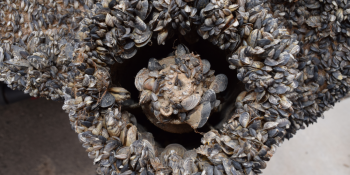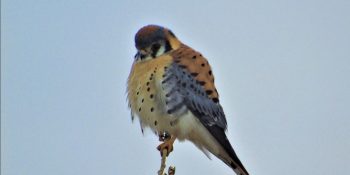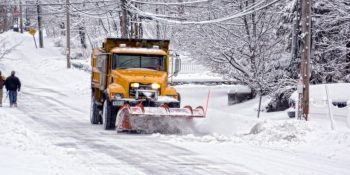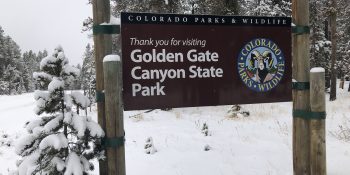HASTY, Colo. – Although many of the birdwatching festivals that occur in Colorado this time of year have either been cancelled or moved online, the birds don’t know it.
So grab your binoculars and field guide and head to your local state park or wildlife area. It’s a great time of year for birding. And birding is a fantastic pandemic activity. It’s naturally socially distanced and you can get out and enjoy Colorado right now.
Never gone birding? Let me help you get started. Below I’ve compiled a list of good spots in Colorado for this time of year. I gathered these tips from experts including CPW Area 14 Wildlife Biologist April Estep, District Wildlife Manager Steve Keefer and Barr Lake State Park Manager Michelle Seubert.
But before I get into their specific recommendations for hot birding opportunities, I want to share my own recent birding experience.
After talking to the experts, I was convinced John Martin Reservoir State Park was a must-see, so my girlfriend, Jamey, and I headed to the reservoir located along U.S. Highway 50 between Lamar and La Junta and we started watching for birds.
We drove slowly as we approached the park because Estep had told me to keep an eye out for burrowing owls.
“We’ve seen them as early as March 1 at John Martin,” she said. “They’re usually on private property as you’re driving into the park from Hasty. They’re in the prairie dog burrows and most of the time they’re standing at a burrow entrance. They also sit on fence posts, barbed wire and on the electric wire on the power poles.”
We saw plenty of prairie dogs, but no owls on this day.
At the park Visitor Center, we picked up a couple brochures on birding then drove across the dam and found a pull-off where we could step out and enjoy the view. We stepped out with our binoculars and were greeted with a 360-degree view of the reservoir, the Lake Hasty campground area and the attached John Martin Reservoir State Wildlife Area beyond.
The John Martin Reservoir SWA includes the entirety of the reservoir and adjacent marshes, riparian forests and upland habitat west nearly to Las Animas.
Immediately above us we saw what were either two juvenile bald eagles or two golden eagles soaring.
Keefer, the CPW wildlife officer for the area, had told me I was likely to see raptors.
“This area has one of the highest concentrations of birds of prey in the state,” Keefer said. “Bald eagles are really common at John Martin and other lakes along the river.
“We’ve counted over 100 at John Martin at times, although 50 to 60 is more common.”
Keefer told me they also see plenty of other birds of prey like red-tailed hawks, golden eagles, ferruginous hawks, sharp-shinned hawks and kestrels.
Jamey and I drove down off the dam and went to the reservoir’s north shore, near the Hasty Campground, where our duck identification skills were put to the test.
We definitely saw redheads and northern pintails, although there were a great many more that left me scratching my head as I scrolled through my copy of The Sibley Guide to Birds.
While we were in the area, we walked quietly around the campground. The park closes 70 campsites from Nov. 1 to March 31 each year because bald eagles like to “roost, loaf, hunt and/or rest” in the tall trees here. The park was preternaturally quiet and beautiful but we didn’t see any bald eagles.
Next, Jamey and I set out to hike what we could of the 4.5-mile Red Shin Hiking Trail. It begins below the dam near the stilling basin and circles the Lake Hasty area through riparian, short-grass prairie and wetland environments. The trail then proceeds to the Santa Fe Trail marker on the north shore of John Martin Reservoir. After only a few minutes of hiking, we were rewarded with the sight of a bald eagle circling further out along the trail.
For our next trip out east, Keefer provided lots of knowledge of birding opportunities in this sometimes overlooked area of Colorado. And he insisted the watchable wildlife opportunities in southeast Colorado are fantastic.
“This area has an incredible diversity of resources,” Keefer said. “You can see a lot of deer and pronghorn and, if you’re lucky, an elk on occasion. You might see a bear. If you hit it right, you can even see bighorn sheep. We do have them in this area.
“Once things warm up a bit, in prairie dog towns you’ll get burrowing owls. Yesterday I went into canyon country to check on some campers and had a coyote run in front of the truck. And earlier this week I saw a golden eagle yesterday take off with a jackrabbit in its talons.”
Now, I want to share the recommendations of the CPW experts. Don’t forget, you need a hunting or fishing license to access Colorado’s state wildlife areas.
From Barr Lake State Park Manager Michelle Seubert:
Barr Lake State Park
For those wanting to stick closer to the Front Range, Barr Lake State Park is a fantastic spot for birders.
“It’s still a good time to see eagles,” Seubert said. “Go to the southwest corner of the lake for eagles. In general, for birding, go to the Niedrach Nature Trail. We’ve had lots of songbirds and black capped chickadees. We have a bird feeding area and birdbath by the nature center and it’s a great place to come in the winter. You’re sitting inside and you can see and hear the birds in the outside area from speakers our volunteers installed.”
Seubert said there were also lots of red wing blackbirds, and “many photographers come out for our northern harriers. The northern harriers have been very prevalent.
Lots of photographers come out for the kestrels as well.”
We offer guided bird walks. Check out our website or Facebook where folks can register. We do two per month and bird walks are always on Saturdays.
The Bird Conservancy of the Rockies at Barr Lake does family guided bald eagle hikes on Fridays. Folks can sign up for those as well. They’ll need to go to the bird conservancy’s website or Facebook to sign up for those. They’re taking single families out right now during the pandemic.
Our Eagle Express and Osprey Express shuttles are by reservation only right now and we’re taking individual families. We also Trackchairs now, which allow visitors with limited mobility to explore designated trails in the park. To book those, folks can call the nature center at 303-659-6005
From Northeast Region Public Information Officer Jason Clay:
St. Vrain State Park
Lots of raptors are out enjoying St. Vrain State Park this winter. They have already seen about a dozen bald eagles, a couple red-tailed hawks, Northern Harriers, Great Horned Owls and American Kestrels.
Osprey and Great Blue Herons will start coming back soon to set up their nests for the spring, though; so no matter what weather we get, it should be a great time for birding.
They have even had two trumpeter swans visiting the park on and off this month, they can typically be found here on Blue Heron Reservoir early in the day.
From Area 14 Wildlife Biologist April Estep:
Fishers Peak State Park
Estep said Fishers Peak, the state’s newest state park located near Trinidad, was so new to her, she didn’t know all the songbirds there yet.
“But that’s a great undisturbed forest there,” she said. “There has to be a lot of birds. I’ve only been monitoring peregrine falcons, but there’s also golden eagles and red-tailed hawks. We don’t have trails set up yet to get to see peregrine falcons, but they nest there on the peak. You’ll need a scope to see them.”
Lathrop State Park
Lots of waterfowl like gadwall, bufflehead, common goldeneyes and redheads. A lot of gulls and western bluebirds at Lathrop, Colorado’s original state park located near Walsenburg. And did you know you can golf at Lathrop State Park?
South Republican SWA
Lots of red-headed woodpeckers and great-horned owls, a variety of waterfowl, and lots of turkey in the South Republican SWA (the old Bonny Reservoir) near Burlington in the far eastern edge of the state.
And if you shoot north and go to Yuma County, toward Wray, you can see greater prairie chickens. There’s a watchable wildlife site called “Wray” and leks just off the side of the road you can see.

Jamey Hastings scans the sky and water at John Martin Reservoir State Park for birds on a recent birdwatching trip. Photo by Travis Duncan.

A Great horned owl sits in a tree. Photo by Carol Delynko.
main photo — American kestrel at St. Vrain State Park. Photo courtesy of Colorado Parks and Wildlife / Jason Clay
Chico Basin Ranch
This fabulous birding location is a private ranch south of Colorado Springs, but birders pay a minimal fee and spend the day birding. You’ll see golden eagles, mountain plovers, burrowing owls, shrikes, prairie falcons, Cassin’s sparrows, and lark buntings.
Monte Vista Wildlife Refuge
Go to Monte Vista on the western edge of the San Luis Valley for the sandhill cranes in March and April. They have a whole lot of waterfowl, too. This year’s festival features online viewing due to COVID-19 restrictions.
Eleven Mile State Park
Eleven Mile is in South Park, not far west of Woodland Park. They have nesting bald eagles and nesting golden eagles. There are white pelicans that nest on an island in the middle of the reservoir. You’ll also see Clark’s nutcracker and mountain bluebirds. And I always see a peregrine falcon when I’m out there.
James M. Robb Colorado River State Park
This area reports lots of birds in the eBird list online. James M. Robb, located east of Grand Junction along Interstate 70, has a lot of waterfowl and Gambel’s quail, which I have not seen, as well as black-crowned night herons.
Red Lion SWA
The Red Lion SWA is in the northeast and it has snow geese and waterfowl. Large numbers of cackling goose and greater white-fronted goose. The cackling goose looks like a Canada goose, but much smaller. Greater white-fronted are big and white with orange bills and they’re meaner than all get-out. They’re neat to see in large numbers.
Waunita Watchable Wildlife Site
You can watch Gunnison sage grouse at the Waunita site from April 1-May 1. It’s private property, but they allow the public to visit. There’s an Audubon group that leads it.
Southeast Colorado birding ideas from DWM Steve Keefer:
Two Buttes SWA
Keefer said Two Buttes State Wildlife Area has some great viewing areas, “especially down around Black Hole.”
Queens Reservoir
Great for waterfowl viewing. Queens Reservoir is part of a group of reservoirs located off U.S. Highway 287 north of Lamar in Kiowa County.
Ordway
The Lake Henry and Lake Meredith will often have eagles in winter
Rocky Ford State Wildlife Area
Lots of diversity at Rocky Ford SWA. You’ll see turkey, upland game birds like pheasant and quail, songbirds, and dove throughout the summer and into fall. You’ll also see deer and an occasional elk.
Find information and directions to these and many other birding areas on the Colorado Birding Trail website at https://coloradobirdingtrail.com, It’s a fantastic resource with tips for seeing birds across the state.
SPREAD THE NEWS
COMMENT, Like, Follow & SHARE @I70Scout










